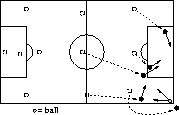The final implemented improvement facilitated by our flexible teamwork structure is the introduction of set-plays, or pre-defined special purpose plays. As a part of the locker-room agreement, the team can define multi-step, multi-agent plans to be executed at appropriate times. Particularly if there are certain situations that occur repeatedly, it makes sense for the team to devise plans for those situations.
In the robotic soccer domain, certain situations occur repeatedly. For example, after every goal, there is a kickoff from the center spot. When the ball goes out of bounds, there is a goal-kick, a corner-kick, or a kick-in. In each of these situations, the referee informs the team of the situations. Thus all the players know to execute the appropriate set-play. A particular referee's message is the trigger condition for each set-play. Associated with each set-play role is a set-play behavior indicating a location on the field as well as an action to execute when the ball arrives. The player in a given role might pass to the player filling another role, shoot at the goal, or kick the ball to some other location. The termination condition for each role is either the successful execution of the prescribed action or the passage of a specified amount of time from the beginning of the set-play.
The locker-room agreement specifies that the roles in the current team
formation are mapped to the set-play roles in the way requiring the
least movement of agents from their position homes. That is ![]() is chosen to minimize
is chosen to minimize ![]() where
where ![]() is the distance from the home location of role r
to the home location of its associated set-play role spr. This
assignment of roles to set-play roles is part of each agent's internal
behavior.
is the distance from the home location of role r
to the home location of its associated set-play role spr. This
assignment of roles to set-play roles is part of each agent's internal
behavior.
For example, Figure 7 illustrates a sample corner-kick set-play. The set-play designates five set-play roles, each with a specific location, which should be filled before the ball is put back into play. Based on the home positions of the current formation, each individual agent can determine the best mapping from positions to set-play locations, i.e. the mapping that requires the least total displacement of the 5 players. If there is no player filling one of the necessary formation roles, then there must be two players filling the same role, one of which must move to the vacant role. In the event that no agent chooses to do so, the set-play can proceed with any single set-play role unfilled. The only exception is that some player must fill the set-play role responsible for kicking the ball back into play. A special-purpose protocol is incorporated into the set-play behaviors to guarantee such a condition.
Once the set-play roles are filled, each player executes the action associated with its set-play role as an external behavior. As illustrated by the player starting the corner-kick in Figure 7, a player could choose among possible actions, perhaps based on the opponent positions at the time of execution. No individual player is guaranteed of participating in the play. For example, the uppermost set-play position is there just in case one of the other players misses a pass or shoots wide of the goal: no player will pass directly to it. Each player leaves its set-play role to resume its former role either after successfully kicking the ball, or after a pre-specified, role-specific amount of time.

Figure 7: A sample corner-kick
set-play. The dashed circles show the positions in the team's current
formation and dashed arrows indicate the locations of the set-play
roles--black circles--that they would fill. Solid arrows indicate
the direction the ball is to be kicked as part of each set-play role.
The set-plays significantly improved CMUnited's performance. During the RoboCup-97 simulator competition, several goals were scored as a direct result of set-plays.